Independent influence of strain difference and mi transcription factor on the expression of mouse mast cell chymases
- PMID: 11141502
- PMCID: PMC1850270
- DOI: 10.1016/S0002-9440(10)63967-3
Independent influence of strain difference and mi transcription factor on the expression of mouse mast cell chymases
Abstract
Expression of mouse mast cell protease (mMCP) genes was examined with particular attention to the transactivation effect of mi transcription factor (MITF) and the expression differences between C57BL/6 (B6) and WB strains. We had reported the enhancing effect of MITF on the expression of mMCP-4, -5, and -6 genes in cultured mast cells (CMCs) of B6 strain, and in the present study we demonstrated the enhancing effect on the expression of mMCP-2 and -9 genes as well. The enhancing effect of MITF on the expression of mMCP-2, -4, -5, -6, and -9 genes was also detected in CMCs of the WB strain. The regulation of mMCP-2, -4, and -9 genes was localized to a specific promoter element (CANNTG) which was recognized and bound by MITF and which was conserved between the B6 and WB strains. On the other hand, the expression of mMCP-2, -4, and -9 genes was smaller in CMCs of the B6 strain when compared to their expression in CMCs of the WB strain. Although mMCP-5 is a chymase as mMCP-2, -4, and -9, and genes encoding all of the chymases are located on chromosome 14, the mMCP-5 gene was regulated in a manner distinct from mMCP-2, -4, and -9 genes.
Figures
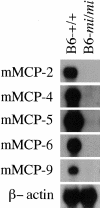


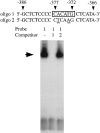


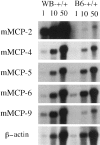
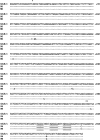

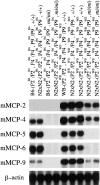

References
-
- Reynolds DS, Stevens RL, Lane WS, Carr MH, Austen KF, Serafin WE: Isolation and molecular cloning of mast cell carboxypeptidase A: a novel member of the carboxypeptidase gene family. J Biol Chem 1989, 264:20094-20099 - PubMed
-
- Serafin WE, Reynolds DS, Rogelj S, Lane WS, Conder GA, Johnson SS, Austen KF, Stevens RL: Identification and molecular cloning of a novel mouse mucosal mast cell serine protease. J Biol Chem 1990, 265:423-429 - PubMed
-
- Serafin WE, Sullivan TP, Condar GA, Ebrahimi A, Marcham P, Johnson SS, Austen KF, Reynolds DS: Cloning of the cDNA and gene for mouse mast cell protease 4: demonstration of its late transcription in mast cell subclasses and analysis of its homology to subclass-specific neutral proteases of the mouse and rat. J Biol Chem 1991, 266:1934-1941 - PubMed
-
- McNeil HP, Austen KF, Somerville LL, Gurish MF, Stevens RL: Molecular cloning of the mouse mast cell protease-5 gene: a novel secretory granule protease expressed early in the differentiation of serosal mast cells. J Biol Chem 1991, 266:20316-20322 - PubMed
Publication types
MeSH terms
Substances
Associated data
- Actions
- Actions
- Actions
- Actions
- Actions
LinkOut - more resources
Full Text Sources
Molecular Biology Databases

